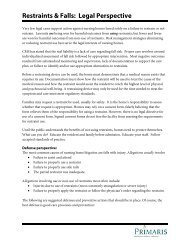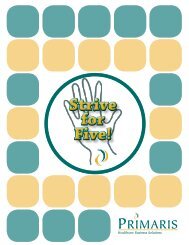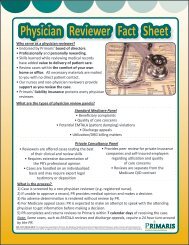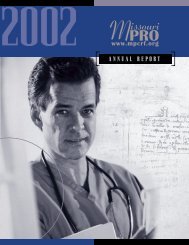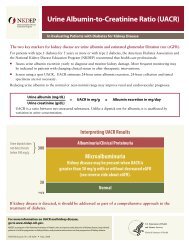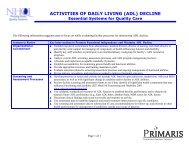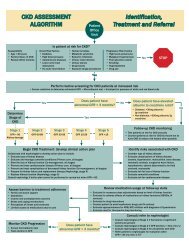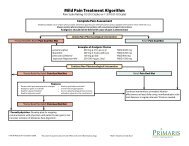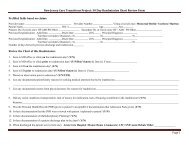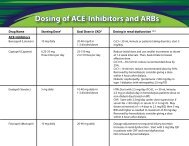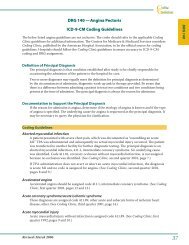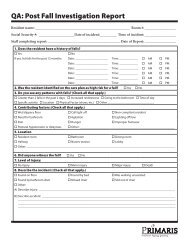DRGs 144/145 â Other Circulatory System Diagnoses With - Primaris
DRGs 144/145 â Other Circulatory System Diagnoses With - Primaris
DRGs 144/145 â Other Circulatory System Diagnoses With - Primaris
Create successful ePaper yourself
Turn your PDF publications into a flip-book with our unique Google optimized e-Paper software.
oding<br />
uidelines<br />
<strong>DRGs</strong> <strong>144</strong>/<strong>145</strong> — <strong>Other</strong> <strong>Circulatory</strong> <strong>System</strong> <strong>Diagnoses</strong><br />
<strong>With</strong> or <strong>With</strong>out Complication/Comorbidity<br />
ICD-9-CM Coding Guidelines<br />
The below listed circulatory system guidelines are not inclusive. The coder should refer to the<br />
applicable Coding Clinic guidelines for additional information. The Centers for Medicare & Medicaid<br />
Services considers Coding Clinic, published by the American Hospital Association, to be the official<br />
source for coding guidelines. Hospitals should follow the Coding Clinic guidelines to assure accuracy<br />
in ICD-9-CM coding and DRG assignment.<br />
Definition of Principal Diagnosis<br />
The principal diagnosis is that condition established after study to be chiefly responsible for<br />
occasioning the admission of the patient to the hospital for care.<br />
Two or more diagnoses may equally meet the definition for principal diagnosis as determined<br />
by the circumstances of admission, diagnostic work-up and/or therapy provided. Be aware that<br />
there is a difference between admitting a patient to treat two conditions and two conditions being<br />
present at the time of admission. The principal diagnosis is always the reason for admission.<br />
<strong>DRGs</strong> <strong>144</strong>/<strong>145</strong><br />
Coding Guidelines<br />
Acquired septal defect due to a previous acute myocardial infarction (AMI)<br />
(less than eight weeks old)<br />
Assign code 429.71, acquired cardiac septal defect, and 410.92, AMI, unspecified site, subsequent<br />
episode of care. (See Coding Clinic, third quarter 1989, pages 5 and 6.)<br />
Acute myocardial infarction (AMI)<br />
Effective October 1, 2005, inclusion terms have been added to category 410, AMI, to indicate<br />
these codes apply to ST-segment elevation myocardial infarction (STEMI) and non-ST segment<br />
elevation myocardial infarction (NSTEMI).<br />
STEMI show an ST segment change on electrocardiogram (ECG) and generally involve the<br />
whole thickness of myocardium from epicardium to endocardium. Codes 410.0-410.6 and 410.8<br />
specify sites that equate to STEMI.<br />
NSTEMI do not show an ST segment change on ECG and do not involve thickness of<br />
myocardium. Code 410.7, subendocardial infarction, should be used to code NSTEMI.<br />
Code 410.9, AMI, unspecified site, does not indicate a site or whether there is an ST elevation. If<br />
only STEMI without a specified site documented, assign a code from subcategory 410.9.<br />
If NSTEMI evolves to STEMI, assign the STEMI code. If STEMI converts to NSTEMI due to<br />
thrombolytic therapy, it is still coded as STEMI.<br />
These codes only apply to abnormal ST-segment elevation involving AMIs. <strong>Other</strong> conditions,<br />
such as acute pericarditis, acute myocarditis, hyperkalemia, Brugada syndrome, pulmonary<br />
embolism, left bundle branch block and Prinzmetal’s angina may cause ST-segment elevation.<br />
An ST-elevation may be a normal variant.<br />
Nontransmural AMI is coded 410.7x regardless of the site. (See Coding Clinic, fourth quarter<br />
2005, pages 69-72.)<br />
Revised: March 2006<br />
43
Effective October 1, 1989, fifth digit subclassifications were added to category 410, AMI, to<br />
indicate whether the episode of care was unspecified, initial or subsequent. (See Coding Clinic,<br />
third quarter 1989, pages 3 and 4.)<br />
AMI/acute and chronic coronary insufficiency<br />
These diagnoses only require a code for AMI. Acute coronary insufficiency, 411.89, is not coded,<br />
since 411.89 is not assigned with a code from 410.xx. Chronic coronary insufficiency, 414.8, can<br />
be coded to show a current history for internal purposes, but it is not necessary. (See Coding<br />
Clinic, first quarter 1991, page 14, and Coding Clinic, November-December 1986, page 12.)<br />
<strong>DRGs</strong> <strong>144</strong>/<strong>145</strong><br />
AMI/cardiac arrhythmias/conduction disorders<br />
If they occur and are treated, paroxysmal supraventricular tachycardia, atrial flutter, atrial<br />
fibrillation, ventricular fibrillation, conduction disorders or complete AV block, Mobitz II AV<br />
block, second-degree AV block and Wenckebach’s block should be coded as an additional code<br />
with an AMI. (See Journal of AHIMA, October 1992, pages 26 - 28.)<br />
AMI/clinical information<br />
AMI may be transmural, involving the full thickness of the ventricular wall, or subendocardial<br />
(nontransmural) involving only the inner one third to one half of the ventricular wall. (See<br />
CodeWrite, May 1993 pages 6 - 8.)<br />
AMI with extension<br />
If a patient has an AMI during the same admission and then an extension or reinfarction<br />
of MI of the same site, assign one code for the site. If the MIs occur in two different sites<br />
during the same admission, assign a code for each site. (See Coding Clinic, volume 10,<br />
number 5 1993, pages 13 and 14.)<br />
Acute myocardial ischemia<br />
Acute myocardial ischemia with an infarction is designated as an AMI, 410.xx.<br />
Acute myocardial ischemia without an infarction but with evidence of occlusion or thrombosis is<br />
assigned code 411.81.<br />
Acute myocardial ischemia without an infarction or evidence of occlusion or thrombosis is<br />
assigned code 411.89, other acute and subacute forms of ischemic heart disease. (See Coding<br />
Clinic, third quarter 1991, page 18.)<br />
Admission for AMI with transfer to another acute hospital<br />
If a patient with AMI is transferred for a heart catheterization and continues to receive treatment for<br />
AMI, the principal diagnosis at the second hospital is AMI. AMI is coded with a fifth digit of “1” at<br />
the second hospital, because the patient was transferred. (See Coding Clinic, volume 10, number 5<br />
1993, page 14, and Coding Clinic, fourth quarter 1992, page 24.)<br />
Cardiac rehabilitation, outpatient, following an AMI<br />
If the encounter is solely for cardiac rehabilitation, assign code V57.89, care involving use of<br />
rehabilitation procedures, other, and sequence as the primary diagnosis. Assign an additional<br />
code of 410.x2, AMI, subsequent episode of care, if the encounter occurs within eight weeks<br />
post AMI. Continue to assign 410.x2 until sessions are completed even if it goes beyond eight<br />
weeks post AMI. If the first rehabilitation encounter is started after the eight week post AMI<br />
time frame, assign code 412, old MI. (See Coding Clinic, third quarter 2001, page 21, and Coding<br />
Clinic, third quarter 1998, page 15.)<br />
44<br />
Revised: March 2006
Codes 425.7 and 425.8<br />
Codes 425.7, nutritional and metabolic cardiomyopathy, and 425.8, cardiomyopathy in other<br />
diseases classified elsewhere, are italicized codes and therefore, should never be sequenced as the<br />
principal diagnosis. The underlying disease is always sequenced first.<br />
Codes V42, V42.1, V42.2, V43.2, V43.3 and V43.4<br />
These codes are only assigned if there are no complications or malfunctions of the organ or<br />
tissue replaced. Codes from category V42 are never assigned with codes from category 996.8,<br />
complications of transplanted organ. (See Coding Clinic, fourth quarter 1998, page 43; Coding<br />
Clinic, third quarter 1998, pages 3 and 4; and Coding Clinic, second quarter 1994, page 9.)<br />
oding<br />
uidelines<br />
Complication of transplanted heart/congestive heart failure (CHF)<br />
A patient with a history CHF prior to a heart transplant was admitted for CHF one year<br />
following the heart transplant. Since CHF affected the transplant organ, this is considered a<br />
complication of the heart transplant, 996.83, with a secondary diagnosis of CHF, 428.0. (See<br />
Coding Clinic, third quarter 1998, page 5.)<br />
Complications of transplanted organ (subcategory 996.8)<br />
These codes are used for rejection of a transplanted organ and complications or diseases of<br />
the transplanted organ. When the function of the transplanted organ is affected, pre-existing<br />
conditions or post-transplant medical conditions are coded as complications of the transplanted<br />
organ. For example, a patient with a heart transplant was admitted for CHF. Because the heart<br />
was affected, assign code 996.83, complications of transplanted organ, heart, plus 428.0, for CHF.<br />
(See Coding Clinic, third quarter 1998, pages 3-5.)<br />
A post-cardiac transplant patient admitted with nasopharyngeal Epstein-Barr virus<br />
lymphoproliferation is assigned code 238.7, neoplasm of uncertain behavior of other and<br />
unspecified sites and tissues, other, 075, infectious mononucleosis, and V42.1, organ or tissue<br />
replaced by transplant, heart. Code 996.83, complications of transplanted organ, heart, should only<br />
be assigned if the physician documents the transplanted heart has become affected by the Epstein-<br />
Barr lymphoproliferative disorder. (See Coding Clinic, third quarter 2001, pages 13 and 14.)<br />
<strong>DRGs</strong> <strong>144</strong>/<strong>145</strong><br />
Congestive or dilated cardiomyopathy/CHF<br />
Congestive cardiomyopathy is a myocardial disease characterized by ventricular dilation,<br />
contractile dysfunction and symptoms of CHF. When a patient is admitted with cardiomyopathy<br />
and CHF and the treatment is directed to the management of CHF, CHF, 428.0, should be<br />
sequenced as the principal diagnosis with cardiomyopathy, 425.4, sequenced as a secondary<br />
diagnosis. (See Coding Clinic, second quarter 1990, page 19.)<br />
Coronary artery stent stenosis<br />
Coronary artery stent stenosis is assigned code 996.72, other complication of internal (biological)<br />
(synthetic) prosthetic device, implant, and graft, due to other cardiac device, implant, and graft.<br />
(See Coding Clinic, third quarter 2001, page 20. This supercedes information published in Coding<br />
Clinic, first quarter 2000, page 10.)<br />
Cytomegalovirus (CMV)/heart transplant<br />
If a heart transplant patient has CMV from his transplanted heart, it is a complication of the<br />
transplanted heart. Assign code 996.83, complication of heart transplant, plus an additional<br />
code 078.5, cytomegalic inclusion disease. (See Coding Clinic, fourth quarter 1993, page 29, and<br />
Coding Clinic, third quarter 1993, page 13.)<br />
Revised: March 2006<br />
45
Dissection of coronary artery<br />
Code 414.12, dissection of coronary artery, was created October 1, 2002. Arterial dissection<br />
is defined as blood coursing within the layers of the arterial wall. Arterial dissections are<br />
common complications of interventional procedures, such as cardiac catheterization or<br />
angioplasty. Spontaneous coronary artery dissection is rare. (See Coding Clinic, fourth quarter<br />
2002, pages 54 and 55.)<br />
<strong>DRGs</strong> <strong>144</strong>/<strong>145</strong><br />
Fifth digits of “0” and “2” for code 410.xx<br />
A fifth digit of “0,” episode of care unspecified, should be avoided. Physician clarification<br />
should be obtained.<br />
A fifth digit of “2,” subsequent episode of care, for category 410, is assigned following discharge<br />
for initial care of AMI to indicate further observation, evaluation or treatment was needed for<br />
a MI that is less than eight weeks old. (See Coding Clinic, fourth quarter 1992, page 24, and<br />
Coding Clinic, third quarter 1989, pages 3 and 4.)<br />
Hypertension/hypotension/complication of procedure<br />
Hypertension documented as a complication of a procedure is assigned code 997.91. (See Coding<br />
Clinic, special edition 1995, page 11.)<br />
Hypotension documented as a complication of a procedure is assigned code 458.2. (See Coding<br />
Clinic, special edition 1995, page 4.)<br />
Hypotension/AMI<br />
Hypotension was considered integral to AMI, so only AMI was assigned a code, until October<br />
1, 1997, when the new code 458.8, other specified hypotension, was created. A post MI<br />
hypotension should be sequenced with AMI, 410.x1 plus 458.8. (See Coding Clinic, fourth<br />
quarter 1997, page 37, and Coding Clinic, third quarter 1995, page 9.)<br />
Increase of premature ventricular contractions (PVCs) due to surgery<br />
Assign code 997.1, cardiac complications. Assign code 427.69, PVCs, as an additional code to<br />
identify the cardiac complication. (See Coding Clinic, fourth quarter 1993, page 42 and 43.)<br />
INOmax therapy<br />
INOmax (nitric oxide/nitrogen) therapy is used to treat persistent pulmonary hypertension in<br />
newborns and pulmonary hypertension in patients with respiratory failure and hypoxia. Code<br />
93.98, other control of atmospheric pressure and composition was assigned until October 1,<br />
2002, when a new code was created, 00.12, administration of inhaled nitric oxide. (See Coding<br />
Clinic, fourth quarter 2002, page 94, and Coding Clinic, first quarter 2002, page 14.)<br />
Ischemic cardiomyopathy<br />
Assign code 414.8, other specified forms of chronic ischemic heart disease, unless<br />
documentation substantiates use of one of the other ischemic heart disease codes, 410-414. (See<br />
Coding Clinic, second quarter 1990, page 19.)<br />
Malfunction of Transjugular Intrahepatic Portosystemic Shunt (TIPS)<br />
Malfunction of TIPS is assigned code 996.1, mechanical complication of other vascular device,<br />
implants and graft. (See Coding Clinic, second quarter 2005, page 8.)<br />
46<br />
Revised: March 2006
oding<br />
uidelines<br />
Mechanical complication of cardiac device, implant and graft, due to coronary<br />
bypass graft (996.03)<br />
As of October 1, 1994, code 996.03, mechanical complication of cardiac device, implant and<br />
graft, due to coronary bypass graft, excludes atherosclerosis of graft 414.02 and 414.03, and<br />
embolism (occlusion NOS) (thrombosis) of graft, 996.72.<br />
Code 996.03 does include occlusion of coronary bypass graft (live or synthetic) due to:<br />
• Failure of the live graft to maintain patency (graft closure during first year) (early graft failure)<br />
excluding that due to progression of atherosclerosis or thrombosis.<br />
• Fibrointimal proliferation (hyperplasia). This is a process distinct from atherosclerotic process.<br />
• Hyperplasia, internal of live graft (late graft closure).<br />
(See Coding Clinic, November-December 1986, pages 5 and 6.)<br />
Mural thrombus 12 weeks post AMI<br />
Assign codes 429.79, other certain sequelae of MI, NEC, for mural thrombus and 414.8, other<br />
specified forms of chronic ischemic heart disease, for MI over eight weeks old. (See Coding<br />
Clinic, third quarter 1989, pages 5 and 6.)<br />
Pacemaker evaluation by telephone<br />
Assign code V53.31, fitting and adjustment of other device, cardiac device, cardiac pacemaker<br />
and 89.45, artificial pacemaker, rate check. (See Coding Clinic, first quarter 2002, page 3.)<br />
<strong>DRGs</strong> <strong>144</strong>/<strong>145</strong><br />
Postoperative complication of cardiac arrest<br />
When cardiac arrest occurs as a postoperative complication, assign code 997.1, complications<br />
affecting specified body systems, not elsewhere classified, cardiac complications, and 427.5,<br />
cardiac arrest. Code 427.5 is also assigned because the nature of the complication is not specified<br />
in category 997, complications affecting specific body systems, not elsewhere classified. (See<br />
Coding Clinic, second quarter 2000, page 12.)<br />
Progressive coronary artery disease (CAD) of post heart transplant<br />
Progressive CAD of a transplanted heart is assigned code 414.0x plus an additional code for organ<br />
or tissue replaced by transplant—heart, V42.1. (See Coding Clinic, second quarter 1994 page 13.)<br />
Replacement of pacemaker pulse generator (battery)<br />
If the battery is demonstrating no problems, but is replaced because it is soon to expire, assign<br />
code V53.31 (V53.3 prior to October 1, 1994), fitting and adjustment of cardiac pacemaker to<br />
designate the replacement. (See Coding Clinic, third quarter 1992, page 3.)<br />
Septicemia due to a vascular access device<br />
Assign code 996.62, infection and inflammatory reaction due to other vascular device, implant<br />
and graft, and sequence as the primary diagnosis, followed by a code for septicemia. (See Coding<br />
Clinic, second quarter 1994, page 13.)<br />
Subsequent episode of care for AMI/congestive heart failure (CHF)<br />
A patient was admitted for CHF one week following an admission for AMI. The principal<br />
diagnosis is CHF, 428.0, because it was the reason for admission and treatment, and AMI,<br />
subsequent episode of care, 410.92, is sequenced as a secondary diagnosis. (See Coding Clinic,<br />
third quarter 1997, page 10.)<br />
Revised: March 2006<br />
47
Transplant rejection/heart<br />
A patient had a heart transplant for idiopathic cardiomyopathy. A cardiac catheterization<br />
with heart biopsy was performed. If the physician identifies a rejection, assign code 996.83,<br />
complication of transplanted organ, heart, as the reason for the visit and 37.25, biopsy of heart,<br />
for the procedure. If rejection is not identified, assign code V67.09, follow-up examination,<br />
following other surgery, as the reason for the visit. Assign code V42.1, organ or tissue replaced<br />
by transplant, heart, as an additional diagnosis and 37.25 for the procedure. (See Coding Clinic,<br />
third quarter 2003, page 16.)<br />
<strong>DRGs</strong> <strong>144</strong>/<strong>145</strong><br />
Unstable angina/AMI/cardiac catheterization<br />
The patient is admitted with unstable angina and has AMI during a cardiac catheterization.<br />
The physician must be queried to determine whether the myocardial infarction was caused by<br />
the cardiac catheterization. If the physician documents that the infarction has been caused by<br />
(is due to) the cardiac catheterization, then the principal diagnosis would be listed as 411.1,<br />
Intermediate coronary syndrome, with additional codes to describe the complicaiton, i.e.,<br />
997.1, Cardiac complications, and appropriate code from the 410.xx series. <strong>Other</strong>wise, only the<br />
infarction would be coded from the 410 category; no additional code would be necessary.<br />
If a patient is admitted with unstable angina and five days later has AMI, only assign a code for<br />
AMI, 410.xx. (See Coding Clinic, fourth quarter 1993, pages 39 and 40.)<br />
Long Term Care Hospitals<br />
Admission for continued treatment of infected AV graft<br />
A chronic renal failure patient was transferred from an acute care hospital to a long term care<br />
hospital (LTCH) following removal of an infected AV graft in her left arm. The patient was<br />
transferred to continue antibiotic therapy and hemodialysis via Quinton catheter. The principal<br />
diagnosis for the LTCH stay is infected AV graft, 996.62, infection and inflammatory reaction<br />
due to internal prosthetic device, implant, and graft, due to vascular device implant, and graft.<br />
(See Coding Clinic, fourth quarter 2003, pages 111 and 112.)<br />
48<br />
Revised: March 2006



